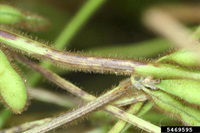Anthracnose Sneaks Up on Soybeans
December 10, 2018


Soybean anthracnose is caused by the Colletotrichum truncatum fungus and can occur throughout U.S. soybean growing regions. The disease can attack soybean stems and pods at any time during the growing season, but it typically strikes when plants near maturity late in the season. While soybean anthracnose is usually a secondary pest that doesn’t cause significant economic damage during most growing seasons, farmers need to be on guard. Soybean anthracnose can result in severe crop loss just before soybeans cross the finish line to successful yields.
Identification and Lifecycle
The most typical symptom of soybean anthracnose appears as random patterns of brown spots on stems and pods. Tiny, black spine-like structures can be seen with a handheld magnifying lens. Leaves can develop brown veins, curl upward and defoliate. Pod blanking (no seeds) can result from anthracnose-infected soybean plants. Soybean anthracnose is one of several diseases that can occur during soybean reproductive phases. The United Soybean Board offers a guide to help farmers identify common problems.
Soybean anthracnose overwinters in infected crop residue and infected seeds. It’s not caused by the same pathogen that causes corn anthracnose, according to the University of Minnesota. Ragweed, alfalfa and velvetleaf serve as hosts for soybean anthracnose. Soybean anthracnose fungal spores don’t thrive in dry weather. Wet, warm and humid weather for 12 hours or longer during blooming and pod set provide an ideal environment for development of soybean anthracnose.
Crop Damage
Soybean anthracnose causes minor damage when stems are infected. The biggest threat comes from pod infections when anthracnose decreases seed quality and yield. Early pod infection leads to empty pods at maturity, while moldy and shriveled seed may be seen in anthracnose-infected pods later in the season, according to University of Oklahoma Extension.
Severe economic damage from soybean anthracnose, which can strike anywhere soybeans are planted, typically occurs in warm, wet and humid weather. University of Illinois research shows that anthracnose can reduce seed quality, stands and yields by 16 to 26 percent or more.
Managing Soybean Anthracnose
Farmers can benefit from several options to manage soybean anthracnose, including variety selection, scouting, cultural practices and fungicides. These best management practices also help minimize the potential for fungicide resistance.
Variety selection
Choosing soybean varieties with genetic disease resistance offers an economical and effective defense against soybean anthracnose and other diseases. While some soybean varieties may provide only partial resistance to soybean anthracnose and other diseases, even partial resistance goes a long way in protecting soybean yields. Seek recommendations from a local seed dealer to determine soybean variety ratings for soybean anthracnose and other pests to help determine the best varieties for individual fields and regions. For best results, plant disease-free, certified soybean seed.
Scouting
Early and frequent scouting for diseases is a routine best management practice to tackle problems before they lead to economic damage. In the case of soybean anthracnose, watch for premature defoliation throughout the canopy when cankers girdle the leaves. The affected branches and stems may resemble a shepherd’s crook. Look for pods that are shriveled with one or more missing seeds.
Cultural practices
Crop rotation remains a solid tactic to reduce soybean anthracnose disease. Tillage to incorporate crop residue from a previous soybean crop can help break down infected residue and reduce overwintering of the soybean anthracnose pathogen.
Fungicides
Fungicide treatments for foliar diseases such as soybean anthracnose are typically recommended between the R3 and R5 (pod development) stages. When stem or pod disease is apparent, take immediate action to apply a fungicide for maximum effectiveness. Agronomists advise that spraying fungicides after the R6 stage isn’t helpful.
Bayer solutions to control diseases in soybeans
A fungicide seed treatment can provide a healthy start for seedlings. Multiple fungal pests can impact soybean seeds and seedlings immediately after planting, and EverGol® Energy SB can protect against pests causing the most damage such as Rhizoctonia solani, Fusarium spp and Pythium spp.
Also, timely foliar fungicide applications help protect soybean plants from anthracnose and other diseases through the season. For farmers, a fungicide decision is a matter of considering production needs, past history in the fields, commodity prices, proper timing and risk management. Plant pathologists typically advise that the R5 growth stage is when an economical fungicide spray window closes. Although applications after R6 may reduce disease, it’s not likely to increase yield enough to justify the cost.
Delaro® fungicide offers an unmatched broad-spectrum control. Its advanced formulation delivers latest triazole technology combined with strobiluron chemistry to deliver best-in-class, dual mode of action residual and improved plant health. In soybeans, the ideal time to first apply Delaro is prior to disease development, between R2 and R5, with applications repeated as necessary. Disease-susceptible cultivars and high-value soybeans are especially vulnerable to the negative effects of diseases and stress. For cost efficiency, Delaro can be tankmixed with insecticides and applied in the same trip across the field.
Before applying any fungicide, please read the entire label for the best possible results and to confirm that the product is effective on the disease you need to control. Not every product is suitable for every situation, and correct application technique will ensure the best results.
©2018 Bayer CropScience LP, 2 T.W. Alexander Drive, Research Triangle Park, NC 27709. Always read and follow label instructions. Bayer and the Bayer Cross are trademarks of Bayer. For additional product information call toll-free 1-866-99-BAYER (1-866-992-2937) or visit our website at www.CropScience.Bayer.us